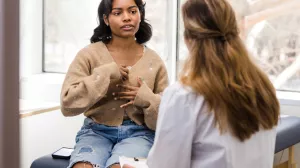February 21, 2025 (BOSTON) – Nine months after the U.S. Food and Drug Administration (FDA) approved self-collected Human Papillomavirus (HPV) testing as an alternative method of cervical cancer screening, the first-ever guidelines have been released to incorporate the option into clinical practice. The guidelines, “Self-collected vaginal specimens for HPV testing: Recommendations from the Enduring Consensus Cervical Cancer Screening and Management Guidelines Committee,” were published in the Journal of Lower Genital Tract Disease on February 21, 2025.
Self-collection for HPV screening was approved by the FDA on May 17, 2024, but until now, no specific recommendations for clinical practice had been released. The FDA approval stipulates that self-collection is performed in a controlled, medical setting, usually a doctor’s office or lab. The new guidelines, developed through a collaboration of 19 national organizations, advise clinicians and patients on how to manage the test results. If the results are negative (the outcome in approximately 90 percent of cases), the patient is recommended to re-test again in three years; most women who test positive (approximately 10 percent) should make an appointment to see their doctor for a Pap test, to determine if biopsies or treatment is needed to prevent cancer. Proceeding directly to biopsy is recommended for women whose self-collection test is positive for HPV 16 or 18, the most aggressive types of HPV.
“Self-collection helps expand access to potentially life-saving screening to patients who would prefer not to have a speculum exam,” said Rebecca Perkins, MD, Obstetrician and Gynecologist and Investigator at the Mother-Infant Research Institute at Tufts Medical Center, Senior Author of the paper and Co-Chair of the Guidelines Development Group. “For people who don’t have a lot of time in their busy schedules, have comfort concerns, trauma or mobility issues, or whose primary care physicians don’t conduct pelvic exams, self-collection may be a good option to help avoid the need for an additional appointment with another specialist.”
Self-collection also may offer additional benefits for the U.S. healthcare system and public health, by relieving patient backlog at hospitals and healthcare centers and increasing the number of women able to obtain cervical cancer screenings during a time of significant primary care physician shortages.
Per the guidelines, self-collection is not recommended for those who experience abnormal bleeding or discharge, take medication that suppresses the immune system, or have had a recent abnormal HPV or Pap results.
Cervical cancer originates in the cervix, the lower portion of the uterus, and is most frequently diagnosed in women aged 35-44. According to the American Cancer Society (ACS), more than 13,300 women will be diagnosed with cervical cancer in the U.S. in 2025. While cervical cancer is highly treatable when pre-cancerous cells are caught early through routine screening, ACS estimates that more than 4,300 U.S. women will die of the disease this year.
“Most cervical cancer cases occur in women who have not been screened,” said Dr. Perkins. “If you are happy with your current screening option, there is no need to make any changes. But with self-collection as a new, viable alternative, we hope that everyone will have a choice that is both comfortable and convenient. If everyone gets screened, we can eliminate cervical cancer.”
###
About Tufts Medicine
Tufts Medicine is an innovative health system that brings together the best of academic and community medicine to deliver exceptional, connected and accessible care. Tufts Medicine is comprised of Tufts Medical Center, the principal teaching hospital of Tufts University and Tufts University School of Medicine, Lowell General Hospital, MelroseWakefield Hospital, Lawrence Memorial Hospital of Medford, Care at Home, and an integrated network of 2,300 physicians in Massachusetts and southern New Hampshire. We treat the most complex conditions, keep our communities healthy and bring research breakthroughs to life.
